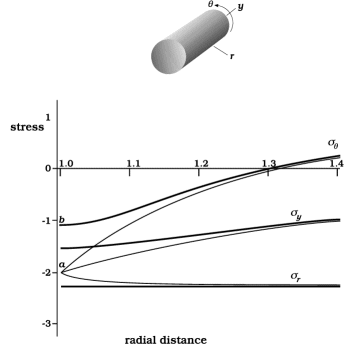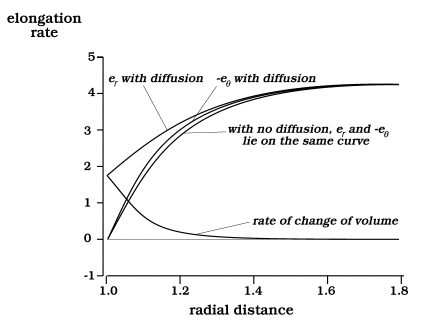|
Details close to the inclusion |
|
Two concepts were illustrated in Figure 5 for the region close to the cylindrical interface. Figure 5A suggests a discontinuity: the idea is that a film of newly-deposited material forms and separates the two regions whose stress fields etc. are described by the equations. In Figure 5B, by contrast, a change in the curvature of the stress surface is suggested. Such a stress field would lead to accumulation not at the interface but in the region close to the interface; material arriving from upstream would accumulate in a dispersed manner continuously throughout the material of the matrix in that region. The occurrence of augen suggests that Figure 5A is closer to what happens in deforming rocks, whereas Figure 5B is closer to what happens in many other instances of chemical diffusion. Actually, even in rocks, the loss of material by diffusion may occur in a dispersed, quasi-continuous manner; it may be only the gain or deposition process that is localized in well defined pockets. Anyway, setting reality aside, the theoretical work I wish to extend (Fletcher 1982; Stephenson 1988; Finley 1994) is more in the manner of Figure 5B and therefore a description more like 5B than 5A was sought.
The relevant equations are given in Appendix 3, and some of the results are shown in Figures 8 and 9. Figure 8 shows stress magnitudes along a radial line to the east in the direction-system of Figure 1. The effects of diffusion are greatest close to the interface. Again the effect is to diminish and smooth out peaks and extreme values; in particular the tangential compression sq no longer drops to such an extreme value. The change of curvature proposed in Figure 5 is seen: concave-upward curvature is noticeable in sq and perceptible in sy . By themselves, these upward curvatures would lead to accumulation of diffusing material and elongation in the tangential and y-directions. However, the theory assumes a totally coherent interface: the matrix is taken as firmly glued to the rigid inclusion and cannot elongate at the interface except radially outward. Instead of causing lateral swelling, then, the influx of diffusing material leads to a stress build-up e.g. from a to b in Figure 8; the material still swells, but constrictive stresses force the effect to occur by radial elongation.
 |
Figure 8 Stress profiles along the east axis. Light lines are profiles unaffected by diffusion; in that condition, sy and the mean stress are equal so the curves here match Figure 7 (inverted) and Figures 5 and 2. Heavy lines show modified stress profiles such as might be present when diffusive transport occurs and gives unequal contributions to the strain rates radially and tangentially. In particular, the concave-upward part of the profile for sq leads to accumulation of material and a tendency toward tangential elongation, but this is exactly countered by sq now being greater than sy and sr which by itself would give tangential shortening. Compared with the light-line profiles, the change in magnitude of sq and the change in curvature have to have equal and opposite effects on the tangential strain rate, if the matrix is to remain coherent with the inclusion. |
 |
Figure 9 Strain-rate profiles along the east axis. The matrix swells, gaining material by diffusion, but because of being coherent with the rigid inclusion, at the interface the swelling is entirely by radial elongation. |
The strain-rate consequences are seen directly in Figure 9. The radial elongation er is noticeably larger when diffusion operates, whereas the tangential shortening hardly changes. Of course the latter is artificially pinned at zero at the interface by our assuming perfect coherence. With this constraint, it appears that as far out as 1.5 or 1.6 on the radial scale, the tangential shortening is actually a little greater when diffusion operates, as if the stress field over-compensates; but the equations are only a coarse approximate solution, and this detail in the curves for eq may be insignificant. The more important point is that we now see unequal strain rates in the radial and tangential directions, and increases of volume due to diffusion that are distributed through the matrix in a continuous manner rather than as a discrete sliver of new material at the interface.
|
| |
Previous Section Home Next Section |

